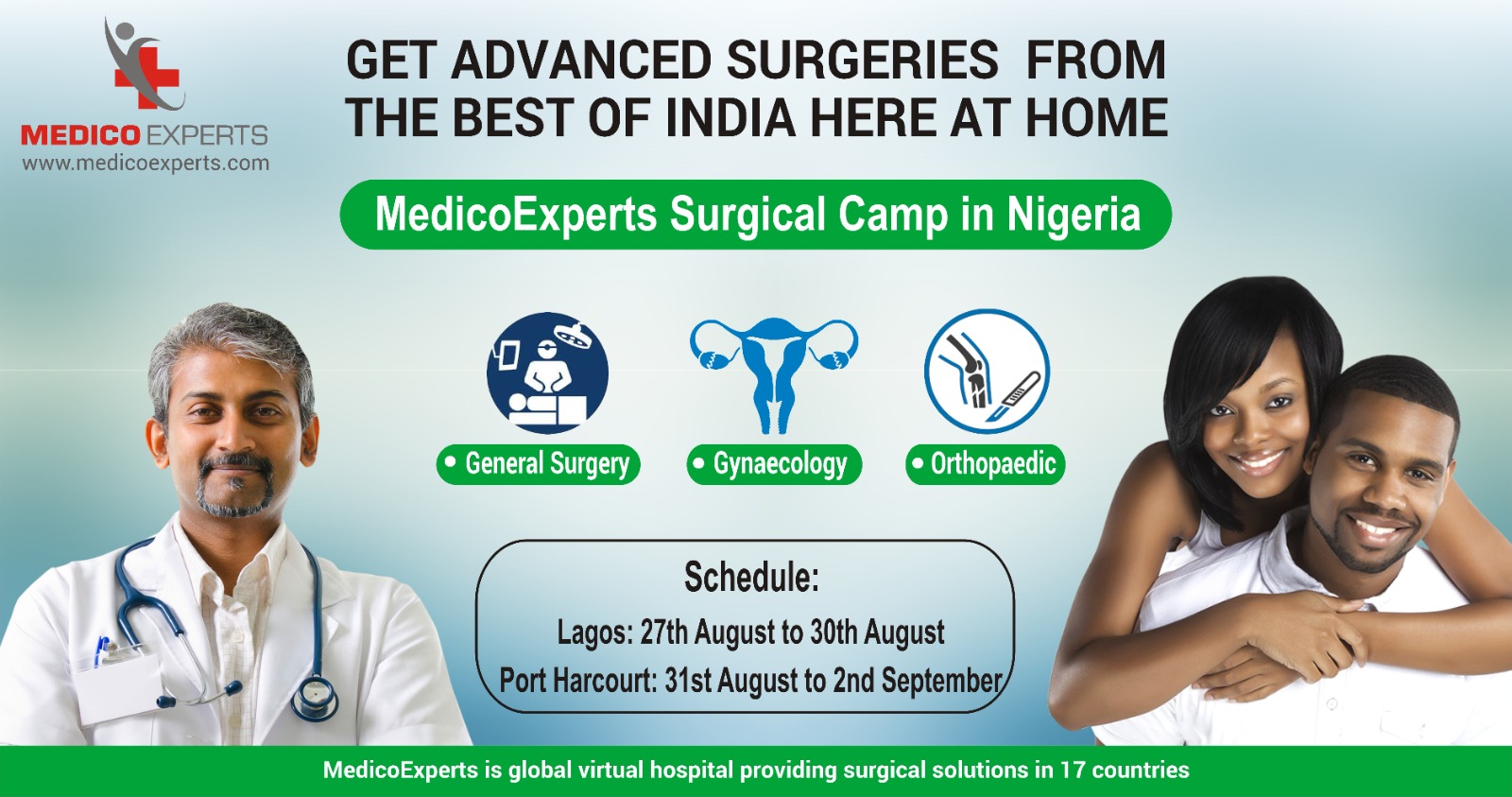Are you living with limited mobility due to avascular necrosis of the femoral head?
AVN occurs when the blood supply to the femoral head (the ball-shaped top of the femur bone) is disrupted, leading to bone tissue death. As a result, the bone collapses and may cause severe pain, limited mobility, and even hip joint dysfunction.
In this blog, we will delve into the causes, symptoms, and various treatment options available for AVN of the femoral head, with a special focus on MedicoExperts stem cell therapy.
Avascular Necrosis of the Femoral Head (AVN) is a debilitating condition that affects the hip joint’s smooth functioning. It is also called osteonecrosis or aseptic necrosis.
Although it’s considered rare, this degenerative condition is observed in about 2 per 10,000 individuals. It mostly affects people aged 40 to 60 years old and is more common in men than women.
So, what causes AVN of the femoral head? How can it be treated? Let’s find out below!
What is Avascular Necrosis of the Femoral Head?
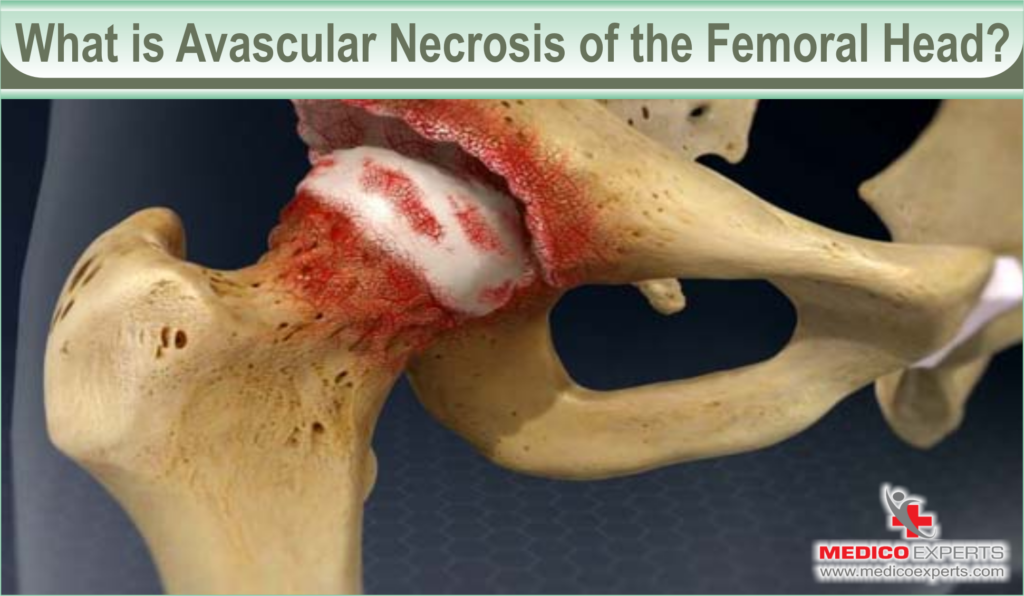
Avascular necrosis of the femoral head (AVN) is a condition in which the femoral head, or the ball-shaped top of the femur bone, experiences loss of blood supply.
Without sufficient blood flow to the bones, they become prone to tissue death and collapse. As a result, medical problems like pain, limited mobility, and even hip joint dysfunction are observed.
When left untreated, it can lead to severe hip joint destruction, leading to the need for a total hip replacement.
Learn more on Avascular Necrosis here..
Causes of AVN of Femoral Head
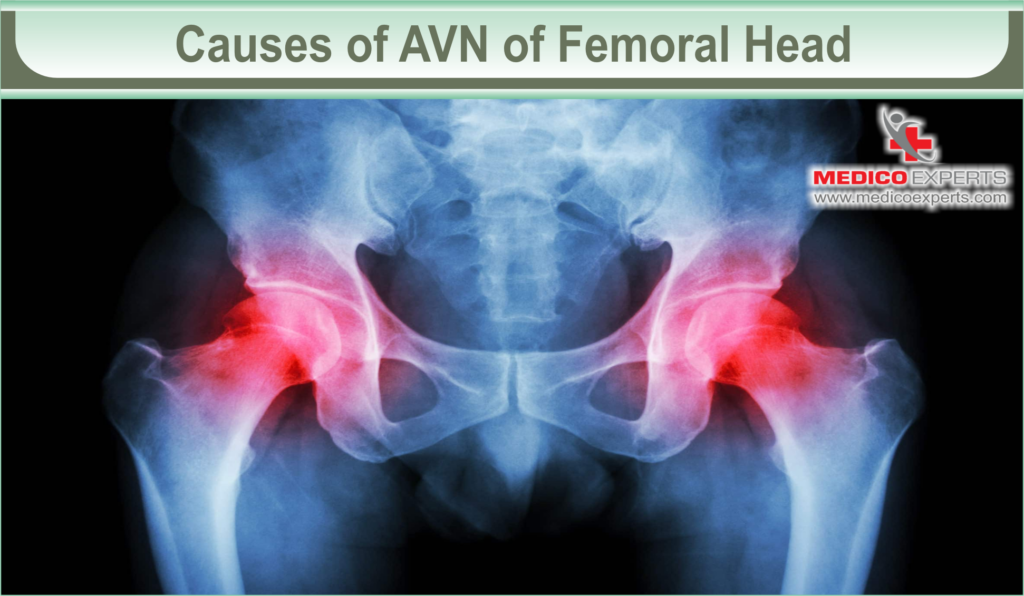
Its occurrence is linked to certain medical conditions that reduce or block blood flow in the femoral head.
VN can have various causes, and identifying the underlying factor is crucial for effective treatment. The most common causes include:
a. Injury or Trauma:
Dislocation or fracture of the hip joint can damage blood vessels, reducing blood flow to the femoral head.
b. Steroid Medications:
Long-term use of high-dose corticosteroids can disrupt the body’s lipid metabolism and lead to AVN.
c. Alcohol and Drug Abuse:
Excessive alcohol consumption and certain drugs can weaken bone tissue and blood vessels, increasing the risk of AVN.
d. Medical Conditions:
Certain medical conditions, such as sickle cell disease, lupus, and HIV, are associated with a higher risk of AVN.
The exact cause of avascular necrosis, when not related to trauma, can sometimes remain elusive. However, a combination of genetic factors, excessive alcohol consumption, certain medications, and other underlying conditions are believed to contribute significantly to its development.
What signs and symptoms can you look out for when you have avascular necrosis of the femoral head?
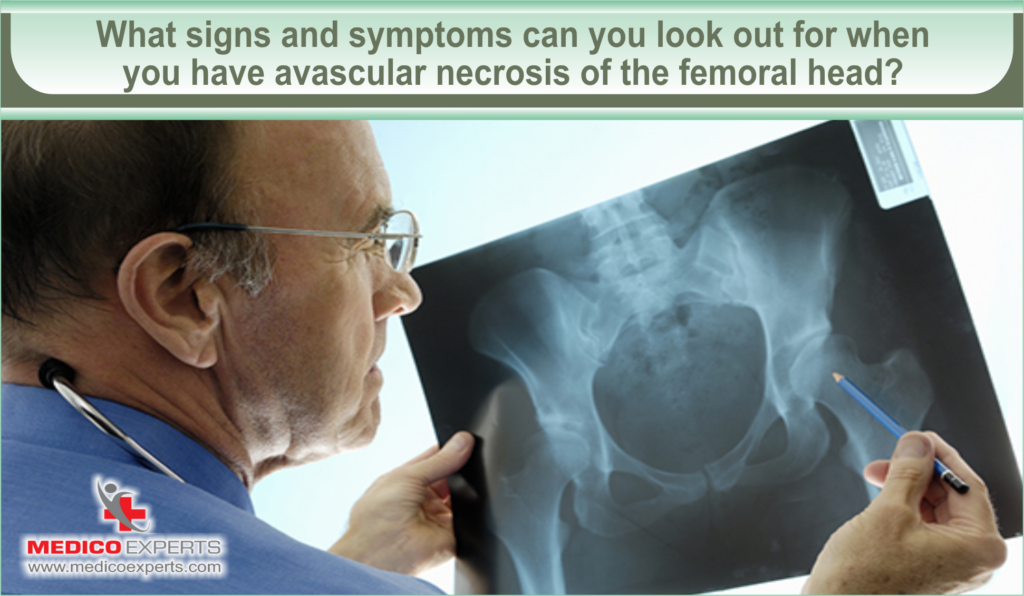
The symptoms of AVN may develop gradually or suddenly, depending on the cause and individual factors. Common signs of AVN include:
a. Hip Pain:
Persistent, deep-seated pain in the hip joint, which may worsen with weight-bearing activities.
b. Limited Range of Motion:
Stiffness and reduced mobility in the hip joint, make it difficult to perform everyday activities.
c. Pain in Groin or Thigh:
Discomfort may radiate to the groin or thigh area, causing additional discomfort.
d. Limping:
To alleviate pain, individuals may develop a limp while walking or moving.
e. Joint Collapse:
In advanced stages, the femoral head may collapse, leading to severe disability.
As the condition worsens, affected joints might start to hurt only when putting weight on them, making it difficult to walk or stand. Eventually, the pain can become constant, even when you’re lying down or at rest.
The severity of the pain can vary from mild discomfort to intense and debilitating. It typically develops gradually over time, starting as a dull ache and progressing to more persistent and sharp sensations.
When avascular necrosis affects the hip, the pain can be localized in the groin, thigh, or buttock area. However, it’s important to note that avascular necrosis can also impact other joints such as the shoulder, knee, hand, and foot.
In some cases, avascular necrosis can occur bilaterally, affecting both sides of the body. For example, it can develop in both hips or both knees simultaneously, leading to a greater impact on mobility and daily activities.
Avascular Necrosis of Femoral Head Treatment Options:
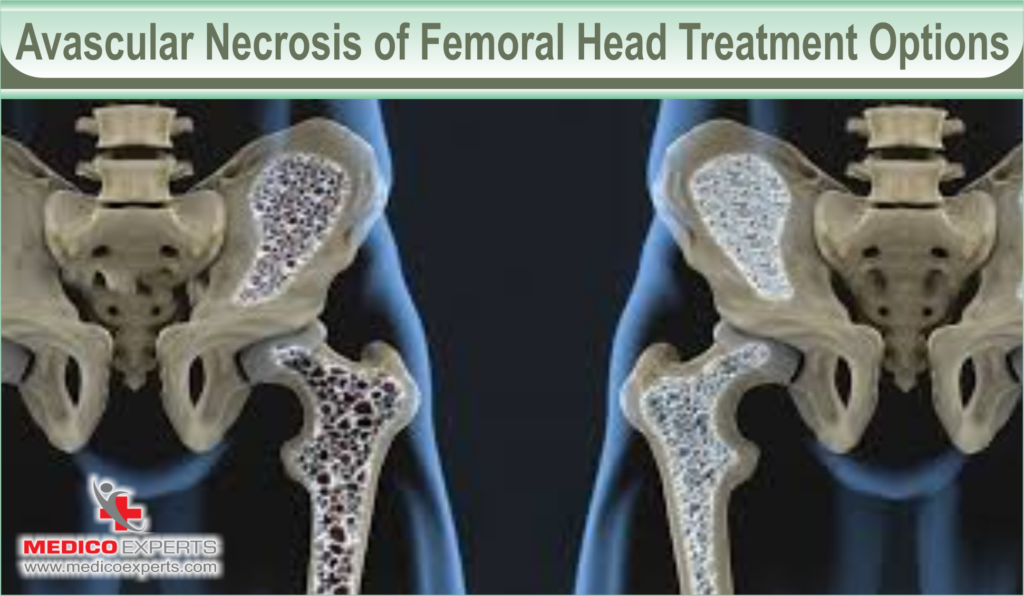
The goal of AVN treatment is to relieve pain, preserve hip function, and prevent further damage to the femoral head.
Conventional Treatment Options for Avascular Necrosis of the Femoral Head
a. Medications:
Medications play a vital role in managing the symptoms of avascular necrosis and providing relief from pain and inflammation. Some common medications used in the treatment of AVN include:
b. Nonsteroidal anti-inflammatory drugs (NSAIDs):
NSAIDs, such as ibuprofen and naproxen, are commonly prescribed to reduce pain and inflammation in AVN. However, long-term use should be monitored due to potential side effects on the stomach and kidneys.
c. Osteoporosis drugs:
Medications like bisphosphonates may be prescribed to prevent further bone loss and improve bone density in patients with AVN.
d. Cholesterol-lowering drugs:
In cases where AVN is associated with high cholesterol levels, statins may be prescribed to manage cholesterol and improve blood flow to the affected area.
e. Medications that open blood vessels:
Vasodilators, such as prostaglandin analogs, can help widen blood vessels and improve blood circulation to the femoral head.
f. Blood thinners:
In some cases, anticoagulant medications may be used to reduce the risk of blood clots and improve blood flow to the affected region.
Surgical and Other Procedures:
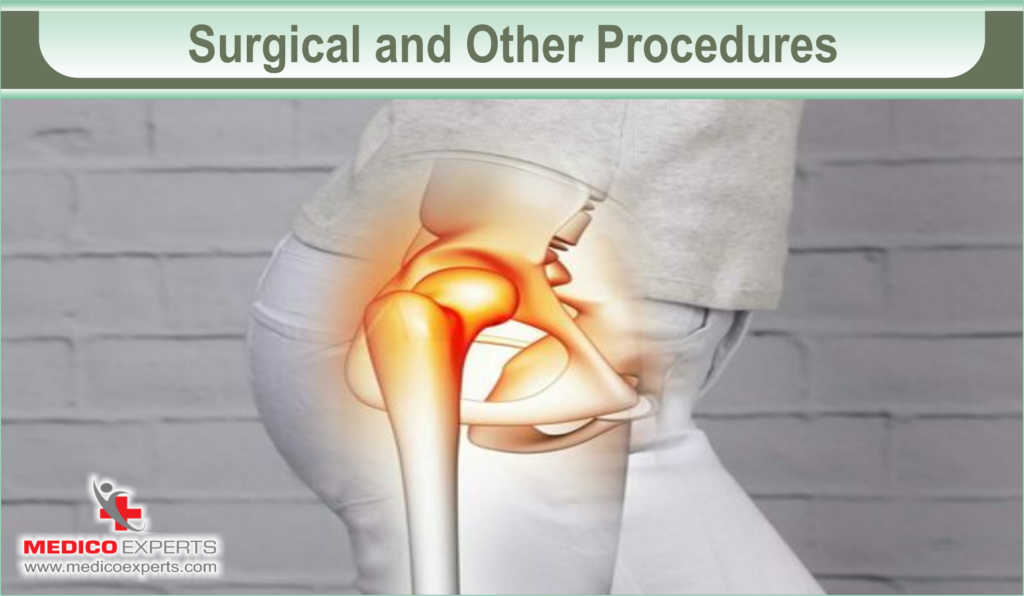
When AVN is diagnosed at an early stage or conservative treatments prove ineffective, surgical interventions may be recommended. The choice of procedure depends on the extent of bone damage and the patient’s overall health.
Some common surgical and procedural options include:
a. Core decompression:
This procedure involves drilling a hole into the affected area of the femoral head to relieve pressure, reduce pain, and stimulate new blood vessel growth. It can slow down or halt the progression of AVN in its early stages.
b. Bone transplant (graft):
In advanced AVN cases, a bone graft from another part of the body or a donor may be used to replace the damaged bone, providing structural support and promoting healing.
c. Bone reshaping (osteotomy):
Osteotomy involves reshaping the femoral head or the hip socket to redistribute weight and reduce stress on the damaged area. It can help delay the need for hip replacement in certain cases.
d. Joint replacement (arthroplasty):
In severe cases of AVN where the hip joint is significantly damaged, total hip replacement may be recommended. This surgical procedure involves removing the damaged femoral head and replacing it with an artificial joint (prosthesis).
e. Regenerative Medicine Treatment:
As mentioned earlier, regenerative medicine, particularly stem cell therapy, has emerged as a promising treatment for AVN. It offers a minimally invasive approach to stimulate tissue repair and regeneration, potentially avoiding the need for more invasive surgeries.
Avascular Necrosis of Femoral Head treatment therapy:
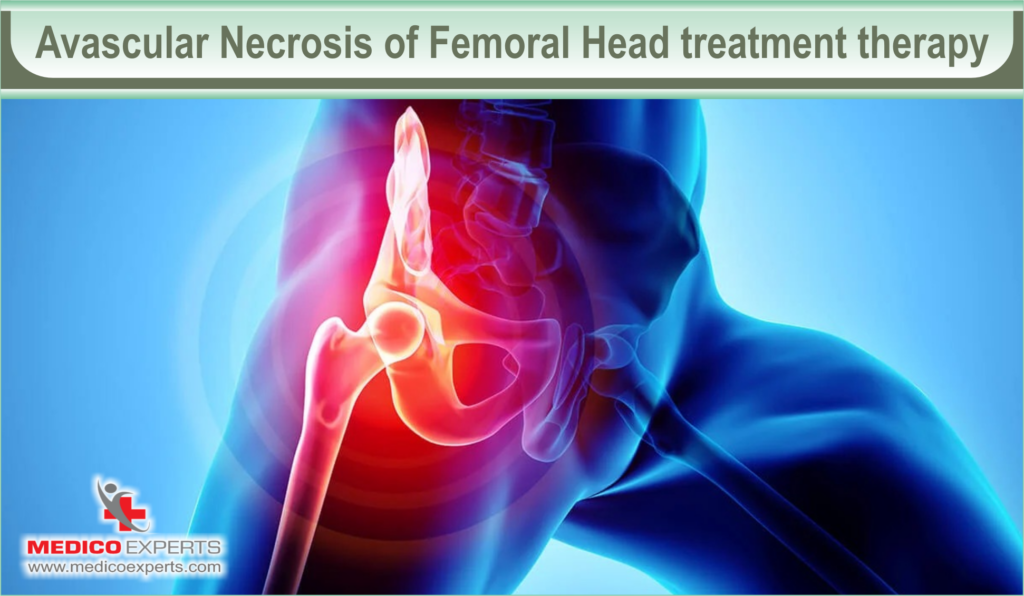
In addition to medications and surgical interventions, certain therapies can complement the treatment of AVN and aid in the recovery process. These include:
a. Rest:
Allowing the affected hip joint to rest and avoiding activities that exacerbate pain can help promote healing and prevent further damage.
b. Exercises:
Physical therapy and specific exercises can help improve joint mobility, strengthen supporting muscles, and maintain the range of motion in the hip joint.
c. Electrical Stimulation:
Transcutaneous electrical nerve stimulation (TENS) and other electrical stimulation techniques can be used to manage pain and promote tissue healing.
d. MedicoExperts Stem Cell Therapy:
MedicoExpert’s stem cell therapy utilizes the patient’s own mesenchymal stem cells (MSCs) derived from bone marrow or adipose tissue. MSCs have the unique ability to differentiate into various cell types, including bone-forming cells (osteoblasts), which makes them an ideal choice for treating AVN.
Advantages of MedicoExperts Stem Cell Therapy:
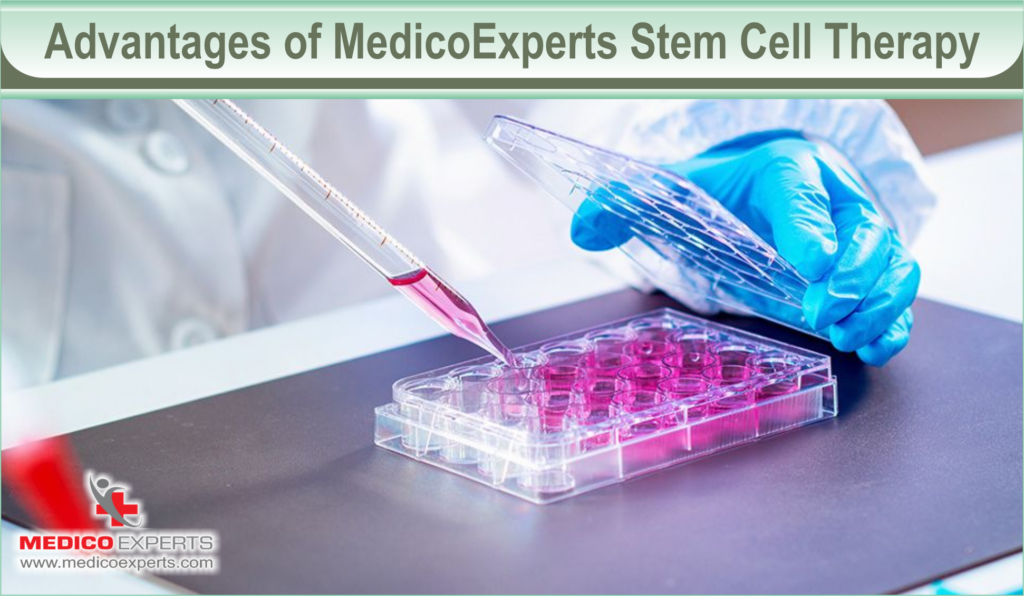
- Non-surgical and minimally invasive
- Utilizes the patient’s own stem cells, minimizing the risk of rejection or adverse reactions
- Stimulates natural healing and tissue regeneration
- Provides long-term relief and restores hip joint function
- Requires minimal downtime and offers a faster recovery compared to conventional surgeries.
Conclusion
Avascular Necrosis of the Femoral Head is a challenging condition that can severely impact a person’s quality of life. While conventional treatments offer some relief, stem cell therapy has revolutionized AVN management with its regenerative potential and minimal invasiveness.
To ensure the best outcome, it is always recommended to consult with a trusted medical professional before undergoing any treatment for AVN.
Medicoexpert’s stem cell therapy provides a beacon of hope for those suffering from AVN, offering a chance to regain mobility and lead a pain-free life. Book your appointment here to find out more about Medicoexpert’s stem cell therapy and its potential benefits.
Frequently Asked Questions:
Q1. Is AVN curable with stem cell therapy?
A. Stem cell therapy has shown promising results in the treatment of AVN by promoting natural healing and tissue regeneration. While it may not cure advanced-stage AVN completely, it can significantly improve symptoms, prevent further deterioration, and restore hip joint function.
Q2. What is the success rate of stem cell therapy for AVN?
A. The success rate of stem cell therapy can vary depending on the severity of AVN, the patient’s overall health, and adherence to post-treatment care. Studies have reported success rates ranging from 60% to 80% in relieving pain and improving hip function.
Q3. Is stem cell therapy safe?
A. Yes, stem cell therapy using the patient’s own cells is considered safe as it reduces the risk of rejection or adverse reactions. The procedure is minimally invasive, and complications are rare.
Q4. How long does it take to see results after stem cell treatment?
A. Patients may start experiencing improvement within a few weeks to several months after stem cell therapy. However, the rate of improvement can vary from person to person.
Q5. Can stem cell therapy delay or avoid the need for hip replacement surgery?
A. In many cases, stem cell therapy has been successful in delaying or avoiding the need for hip replacement surgery. By promoting tissue repair and regeneration, it can potentially preserve the hip joint and extend its lifespan, especially in early-stage AVN cases. Medicoexpert’s stem cell therapy has helped many patients avoid the need for hip replacement surgery.


